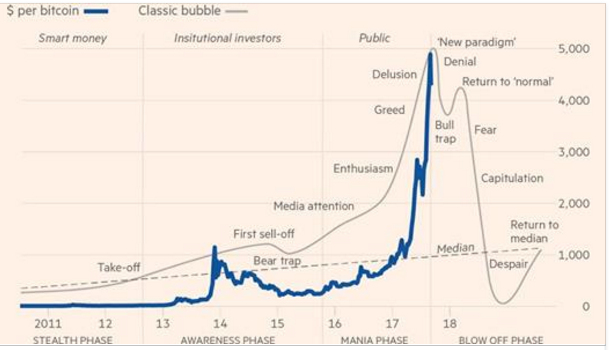For those who study financial market manias, it’s hard to pick the ultimate bubble. The Witte Croonen, a very common tulip bulb, rose 26 times (2600%) in price just in the month of January 1637, only to crash a month later. More recently, at the end of the last millennium, a few $5 beanie babies reportedly sold for $10,000, at the same time dot com stocks soared. After 9/11, I watched an acre of Las Vegas residential land go from $25,000 to nearly a million during the housing boom.
This spring, investors Doug Kass and Bill Gross thought the bubble bar was set even higher. “Near zero to negative sovereign debt yields in Europe represent the bubble of all investment bubbles, dwarfing even the Nasdaq bubble of 16 years ago,” Kass wrote in a note to clients on April 15.
Janus Capital’s Gross called German 10 year Bunds “The short of a lifetime. Better than the pound in 1993,” in an April 21st tweet. On that day the sovereign paper in question was The More Things Change... 22 Journal of Prices & Markets yielding .108%, while lending money to the German government for two years and five years produced negative yields of .262% and .139%, respectively. Paying for the privilege of lending to a borrower, sovereign or otherwise, certainly qualifies for bubble status.
A return to sanity is slow. In June investors still had to pay to lend the German government money for two years (-.21% yield) while five year yields had “jumped” to a positive .06% and the ten year yields are at .54% after a week-long selloff.
On Thursday May 7th, the volume for 10- year bund futures was double what the market has averaged over the past five years. On that day the rate “spiked” to .786% before falling back under .58% in market action described as “complete carnage” by Thomas di Galoma of ED&F Man Capital Markets.
At these microscopic yields any sort of move beyond a couple basis points seems catastrophic. Mike Bird, writing in bold letters for Business Insider, called the increase in yield, “the biggest upward climb in a quarter century.” The Wall Street Journal reported on May 8th, “Traders were unable to pinpoint a single factor driving the selloff.” The idea that bonds were irrationally overvalued didn’t occur to them.
In October, the United States government, itself saddled with $18 trillion of debt, was able, for the first time in its history, to float 3-month bills paying no yield. The Wall Street Journal reported, “On Monday, the yield on the one-month bill traded at negative-0.02% and the threemonth yield was zero.” In an extraordinary understatement, Thomas Simons, money-market economist in the Fixed Income Group at Jefferies LLC. told the WSJ, “It is a bizarre outcome, but that is the world we are living in right now” (Zing 2015).
A world where “The Fed’s closely watched ‘dot plot’ revealed that at least one committee member floated the idea that a fed funds rate below zero might be an appropriate target for the remainder of this year and next,” writes Alex Rosenberg for CNBC. (Rosenberg 2015)
In heat of the market, as speculators give chase, bubble values make perfect sense. After all, God ain’t making no more land. Certain plush toys would become rare stores of value like Rembrandts. In the long run, stocks and houses always increase in value.
The bund bubble has had its own apologists. “One should be careful not to mix up the yieldto-maturity concept with total returns which can be positive even if yields are negative,” said Michael Leister, a senior rates strategist at Commerzbank AG in Frankfurt.
This takes the search for a greater fool to new extremes. Instead of receiving payment, bund buyers make a payment, but it will all work out in the end say the bulls because bond prices will increase even further with greater negative yields. The “Elliott Wave Financial Forecast” for May called this “a terrible rationalization for buying these bonds” (Hochberg and Kendall 2015).
EWFF went on to point out the mania was a euro-wide phenomenon. “More than 30% of all government debt in the Eurozone---around €2 trillion---is trading on a negative interest rate, according to the Telegraph (U.K.).” While the Elliott Wave analysts are famously in the deflation camp, they said, “The world’s bond markets are in uncharted waters” (ibid.)
David Stockman (2015) called it “flat-out derangement.” People rush into bubbles time after time thinking they can’t lose. Investors have been burned by the crashing of multiple bubbles in the unbacked fiat currency era. Government bonds would seem the ultimate in safety especially with ECB head Mario Draghi ready to unleash a Euro-QE bond buying binge. People forget what kind of shape the borrowing Euro countries are in. Stockman reminds us, “After all, the aging, sclerotic economies of the EU have been making a bee line toward fiscal insolvency for most of the last decade” (ibid.).
What’s old is new again as Draghi has promised the European Central Bank will buy €60 billion of bonds every month from March 2015 to September of 2016 to rejuvenate the flagging Eurozone economy. Conditions weren’t altogether different in 1715 France as Louis XIV had left the country deeply in debt and on the verge of bankruptcy.
Enter John Law, the first all-powerful central banker. Law’s prescription for economic depression was way ahead of his time -- create money, and the use of banks was the way to do it. In his book Money and Trade Considered With A Proposal For Supplying The Nation With Money, Law wrote of banks, “So far as they lend they add to the money, which brings a Profit to the Country, by employing more People, and extending Trade; They add to the Money to be lent, whereby it is easier borrowed, and at less use, and tho none suffer by it” (Law 1705: 22).
In addition to establishing General Bank, Law wrote in a letter to the Regent, Philip, Duke of Orléans, “I will lighten the burden of the King and the State in lowering the rate of interest on money, not by legal methods, but by an abundance of specie” (quoted in French 2009: 48). The specie Law was referring to was not metallic, but a new type of credit.
Law’s vehicle for Quantitative Easing was the Company of the West. The company’s primary asset was the exclusive trading privilege, granted by the French government, with Louisiana. The privilege was granted in exchange for the company’s conversion of the government’s debt into company stock at a lower interest rate.
Law flooded the market with banknotes and company shares as the price rocketed from 500 livres to 10,000 livres at the height of the Mississippi Bubble.
When investors tried to bail out and convert their shares or banknotes into gold and silver, Law used heavy handed measures to stop the run. Law’s decree of May 21, 1720 making banknotes more valuable than gold cast a cloud of doubt over what was supposed to be an infallible system.
And while this was the beginning of the end for Law, who was forced from the country in disgrace, financial entrepreneurs in Britain where copying his system in order to refinance Britain’s debt using South Sea Company stock. The scheme unleashed the South Sea Bubble, leaving many speculators, including Sir Isaac Newton, penniless.
What will be the ultimate financial bubble? Whether it has come and gone, or we are living it now, what we know for sure is central bankers are behind these manias with their money machines. Until central banks are banished, there will be many more bubbles to study, compare, and gasp at.
Originally appeared in The Journal of Prices & Markets
References
French, Douglas. 2009. Early Speculative Bubbles and Increases in the Supply of Money. Auburn, AL: Ludwig von Mises Institute.
Hochberg, Steve and Peter Kendall, eds. 2015. “The Elliott Wave Financial Forecast”, May.
Law, John. [1705] 1997. “Money and Trade Considered, with a Proposal for Supplying the Nation with Money” in, Antoin E. Murphy (ed.) Monetary Theory: 1601 – 1758. London: Routledge.
Rosenberg, Alex “Could Negative Rates be Next on the Fed’s Policy Menu?” CNBC.com September 20, 2015.
Stockman, David “The Draghi Derangement: 2 Trillion Euro Government Bonds Trading At Negative Yield” David Stockman’s Contra Corner March 3, 2015.
Zing, Men “Yield of 0% a First at 3-month Treasury-Bill Sale” Wall Street Journal, October 5, 2015.





